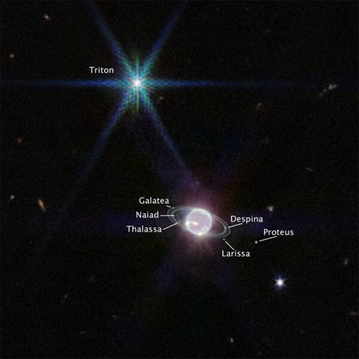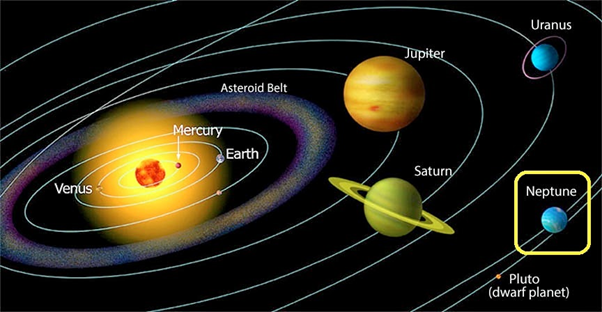

23rd September 2022 (6 Topics)
Context
The James Webb Space Telescope has captured the clearest image of Neptune, its rings, and its moons since the Voyager 2 spacecraft did a fly-by in 1989.
About
About the image:
- Neptune does not appear blue in the Near-Infrared Camera (NIRCam) image from Webb because it captures light in the near-infrared range.
- Also, methane gas so strongly absorbs red and infrared light that the planet is very dark at those wavelengths unless high-altitude clouds are present.
- The bright streaks and spots on the planet are such methane-ice clouds which reflect sunlight before it is absorbed by the methane gas.
- A thin line of brightness can be seen circling the planet’s equator. This could be a signature of the global atmospheric circulation that powers the winds and storms on Neptune.
- The atmosphere descends and gets warm at the equator, this causes the glows at infrared wavelengths.
- Apart from the planet itself, Webb also captured seven of its 14 known moons.
- The very bright point of light with diffraction spikes at the top left of the image is Neptune’s largest moon Triton.
|
Triton: Triton has a surface covered in frozen condensed nitrogen and it reflects around 70 per cent of the sunlight that hits it. It far outshines Neptune in this image take in the near-infrared wavelength. |

About Neptune:
- Neptune is the eighth and most distant planet from the sun. This means that Uranus is its only neighbouring planet.
- Neptune is dark, cold, and windy. It’s the last of planets in our solar system.
- The composition of Neptune is similar to Uranus – ice and rock with about 15% hydrogen and a little helium. Its atmosphere is made up of hydrogen, helium, and methane.
- Neptune’s blue colour is primarily due to the absorption of red light by methane in the atmosphere. Neptune winds are the fastest in the solar system reaching a speed of 2000 km/hr.
- Neptune is located 30 times farther away from the Sun than our planet.
- At that distance, the sun is so distant, small and faint that mid-noon on the icy planet is similar to a dim twilight on Earth.
- Compared to Jupiter and Saturn, which are gas giants, the ice giant Neptune is much richer in elements that are heavier than hydrogen and helium.
- Neptune appears blue in Hubble images captured at visible wavelengths, which is caused by the presence of gaseous methane.

More Articles


